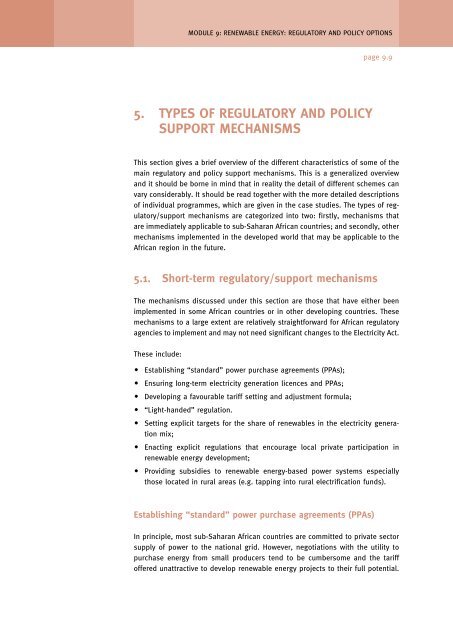Regulatory and policy options to encourage development of ...
Regulatory and policy options to encourage development of ...
Regulatory and policy options to encourage development of ...
- No tags were found...
Create successful ePaper yourself
Turn your PDF publications into a flip-book with our unique Google optimized e-Paper software.
MODULE 9: RENEWABLE ENERGY: REGULATORY AND POLICY OPTIONSpage 9.95. TYPES OF REGULATORY AND POLICYSUPPORT MECHANISMSThis section gives a brief overview <strong>of</strong> the different characteristics <strong>of</strong> some <strong>of</strong> themain regula<strong>to</strong>ry <strong>and</strong> <strong>policy</strong> support mechanisms. This is a generalized overview<strong>and</strong> it should be borne in mind that in reality the detail <strong>of</strong> different schemes canvary considerably. It should be read <strong>to</strong>gether with the more detailed descriptions<strong>of</strong> individual programmes, which are given in the case studies. The types <strong>of</strong> regula<strong>to</strong>ry/supportmechanisms are categorized in<strong>to</strong> two: firstly, mechanisms thatare immediately applicable <strong>to</strong> sub-Saharan African countries; <strong>and</strong> secondly, othermechanisms implemented in the developed world that may be applicable <strong>to</strong> theAfrican region in the future.5.1. Short-term regula<strong>to</strong>ry/support mechanismsThe mechanisms discussed under this section are those that have either beenimplemented in some African countries or in other developing countries. Thesemechanisms <strong>to</strong> a large extent are relatively straightforward for African regula<strong>to</strong>ryagencies <strong>to</strong> implement <strong>and</strong> may not need significant changes <strong>to</strong> the Electricity Act.These include: Establishing “st<strong>and</strong>ard” power purchase agreements (PPAs); Ensuring long-term electricity generation licences <strong>and</strong> PPAs; Developing a favourable tariff setting <strong>and</strong> adjustment formula; “Light-h<strong>and</strong>ed” regulation. Setting explicit targets for the share <strong>of</strong> renewables in the electricity generationmix; Enacting explicit regulations that <strong>encourage</strong> local private participation inrenewable energy <strong>development</strong>; Providing subsidies <strong>to</strong> renewable energy-based power systems especiallythose located in rural areas (e.g. tapping in<strong>to</strong> rural electrification funds).Establishing “st<strong>and</strong>ard” power purchase agreements (PPAs)In principle, most sub-Saharan African countries are committed <strong>to</strong> private sec<strong>to</strong>rsupply <strong>of</strong> power <strong>to</strong> the national grid. However, negotiations with the utility <strong>to</strong>purchase energy from small producers tend <strong>to</strong> be cumbersome <strong>and</strong> the tariff<strong>of</strong>fered unattractive <strong>to</strong> develop renewable energy projects <strong>to</strong> their full potential.










